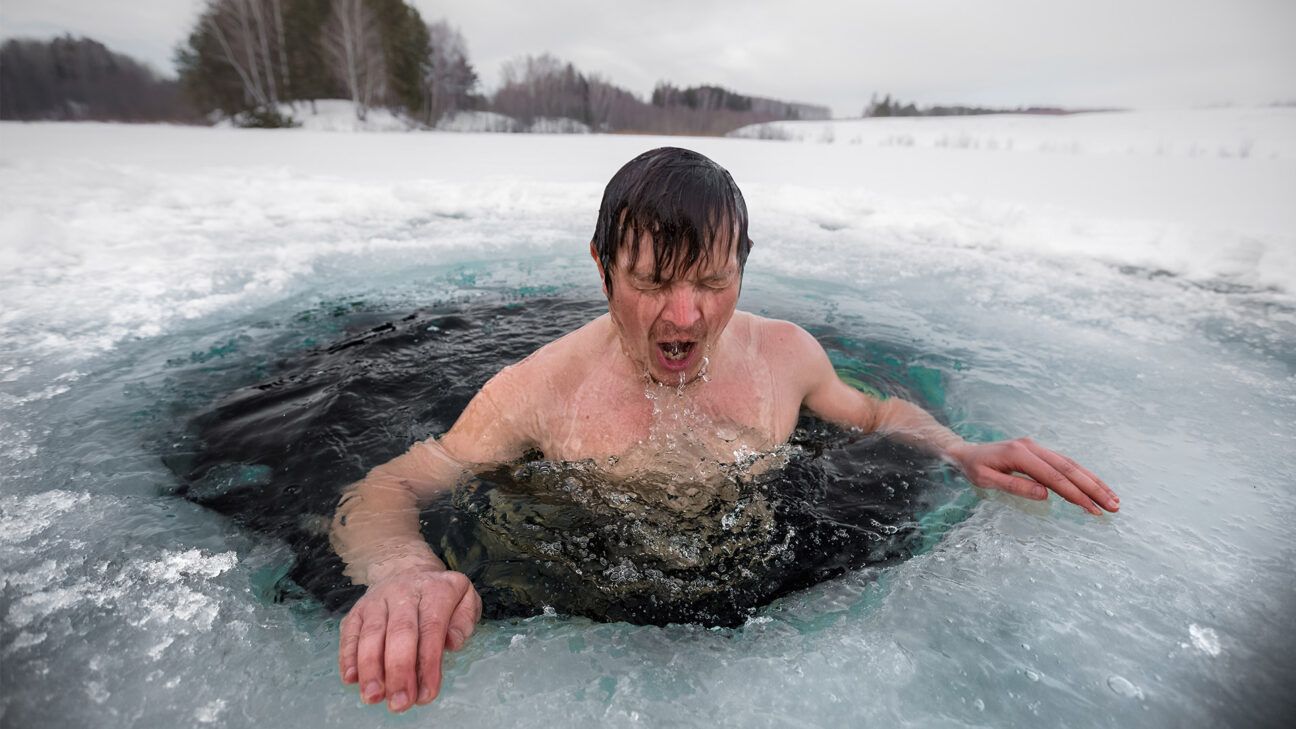
- A new review found the Wim Hof Method, a form of the cold water immersion therapy, lacks sufficient scientific evidence and needs further investigation.
- While cold water immersion therapy may offer some potential benefits, it may not be safe for everyone.
- A 2022 lawsuit was filed against Wim Hof after a teenage girl drowned and other people have allegedly drowned after practicing this form of cold water exposure.
- Experts recommend starting a cold plunge practice with a warm-up, choosing a safe temperature, and gradually increasing the duration over time.
The cold water plunge has become a wellness trend in recent years, with many health influencers and experts touting its benefits, from reduced inflammation to heart and weight loss.
Wim Hof, an extreme athlete from the Netherlands and founder of the Wim Hof Method (WHM) is widely known for breaking records in cold water exposure. The “Iceman’s” method combines cold therapy and a specific breathing technique designed to build mind-body resilience.
Proponents of the Wim Hof Method praise this practice for its health benefits, but adverse reactions and drownings tied to the technique have been reported.
Now, new research brings the health benefits of the Wim Hof Method into question. A systematic review, published March 13 in
“The most compelling aspect of this study is its exploration of the potential benefits of the Wim Hof Method on reducing inflammation in healthy participants,” study author Dr. Omar Almahayni from Warwick Medical School at the University of Warwick, told Healthline.
“However, given that all studies included in our systematic review exhibit ‘high concern’ for risk bias, it is important to acknowledge that the Wim Hof method is still in its early stages of investigation, with limited trials conducted thus far. Due to the low methodological quality and small sample sizes across these studies, caution must be exercised in interpreting the findings,” Almahayni said.
While more studies on the benefits of the Wim Hof Method are needed, the results did show promising findings in the inflammatory response category.
“The focus of future studies should further investigate the benefits of WHM in non-healthy participants with inflammatory disorders and explore the use of Wim Hof breathing method to enhance exercise performance,” a spokesperson for Wim Hof told Healthline.
Almahayni said the Wim Hof Method could potentially help lower inflammation in people with inflammatory disorders, but cannot be prescribed without further, more rigorous research.
“To be able to recommend Wim Hof Method in an unwell population, future trials should publish a protocol outlining their experiment before starting the trial, increase the sample size, and make sure to account for loss to follow-up,” Almahayni noted.
“To address potential biases and enhance methodological rigor, future trials should adhere to pre-published protocols, incorporate larger sample sizes, account for loss to follow-up, and implement blinding of outcome assessors. By adhering to these guidelines, future research can provide a more comprehensive understanding of the Wim Hof method’s efficacy and potential applications,” Almahyni explained.
The Wim Hof spokesperson said the organization will continue collaborating with researchers to conduct larger studies.
“We’re dedicated to rigorously validating our method’s benefits and expanding our understanding through robust scientific scrutiny. Promising results have been published, and more studies and results are on their way,” the spokesperson said.
Other studies have examined the potential health benefits of cold water therapy and the Wim Hof Method specifically.
A
Anecdotally, however, ice baths and cold water immersion therapy may offer some benefits. Still, it’s important to note these wellness practices may not be suitable for everyone.
Dr. Dominic King, DO, a sports medicine physician at the Cleveland Clinic, recommended consulting with a healthcare professional before trying any form of cold plunge therapy.
Despite limited empirical evidence, King said there may be some potential health benefits of cold plunge therapy:
- Improved insulin resistance: A 2023 study found that a cold water plunge protected against insulin resistance and lowered diabetes risk.
- Weight loss: A
2022 study shows that cold exposure may stimulate brown fat activity, which is responsible for burning calories to generate heat, potentially contributing to weight loss efforts. - Reduced muscle soreness: Cold water immersion may help alleviate muscle soreness and inflammation, which is beneficial after intense exercise.
- Faster recovery: Ice baths may help
expedite the recovery process by reducing inflammation and enhancing blood circulation, which may help repair damaged tissues more quickly. - Improved muscle repair: Cold exposure may stimulate the release of proteins and growth factors that aid in muscle repair and growth.
- Enhanced circulation: The cold temperature causes blood vessels to constrict and then dilate once you exit the ice bath, potentially improving overall blood circulation.
- Decreased swelling: Cold therapy may reduce swelling by constricting blood vessels and limiting the accumulation of excess fluid in tissues.
- Pain relief: Cold exposure may numb nerve endings, providing temporary pain relief and reducing discomfort.
- Increased metabolism: The body’s metabolic rate may temporarily increase in response to cold exposure as it works to maintain a stable core temperature.
- Boosted immune system: An
older study suggests that cold exposure might stimulate the production of immune cells, potentially enhancing immune system function. - Improved mood: A
2023 study suggests that cold exposure is believed to trigger the release of endorphins and other mood-boosting neurotransmitters. - Increased oxygen uptake: Practicing cold water immersion and deeper breathing techniques could increase oxygen uptake, which may have a positive effect on respiratory function.
Reports of multiple deaths due to drowning have been tied to the Wim Hof Method. In 2022, for instance, a $67 million lawsuit was filed against Hof for the drowning of a teenage girl who practiced the Wim Hof Method in her pool in Long Beach, CA. The case against Hof is still pending.
In 2023, at least three people drowned practicing the Wim Hof breathing technique, and another person died from cold water immersion.
The cause of death from practicing the Wim Hof Method appear to be loss of consciousness and hyperventilation in or near water.
Before trying an ice bath, it’s important to determine whether it’s a safe wellness practice for you.
“The duration and intensity of cold exposure should also be approached with caution to avoid adverse reactions,” King told Healthline. “Check with your doctor beforehand, as ice baths can have negative and potentially dangerous effects on people who have certain medical conditions.
According to King, people with the following health conditions should avoid cold water immersion therapy:
- heart disease
- high blood pressure
- diabetes
- peripheral neuropathy
- poor circulation
- venous stasis
- cold agglutinin disease
If your doctor clears you for cold water therapy, King recommended the following practices:
Start with a warm-up
Before you even enter the cold water, warm up your body through light exercise or movement. This may help increase blood flow, making the cold exposure more tolerable.
Choose a safe temperature
The temperature of the water may vary depending on what you’re comfortable with and the purpose of the cold plunge. Many people start with water around 50–60°F (10–15°C) and gradually work their way down to colder temperatures over time.
Duration
Begin with short durations and gradually increase them. A common starting point is around 1–2 minutes for the initial exposure. You can then aim to increase your time in the water as your body adapts. However, never push yourself to stay longer than you’re comfortable.
Frequency
Start with a frequency that suits your body’s response. For beginners, 2–3 times per week might be sufficient. As you adapt, you can increase the frequency if desired.
There are other ways to practice cold water immersion aside from the Wim Hof Method. For example, you might begin with either full or gradual immersion:
Full immersion
Submerge your entire body in the cold water, allowing your body to adapt to the temperature. Focus on deep breathing to help relax your body and reduce the initial shock.
Gradual immersion
If full immersion is too intense initially, you can start by immersing your feet, legs, and gradually progressing to the upper body.
King offered additional tips to stay healthy and safe during cold water immersion therapy:
- Breathing techniques: Controlled breathing may help manage the body’s response to the cold. Try deep, slow breaths to stay calm and reduce stress.
- Listen to your body: Pay attention to how your body responds. If you feel severe discomfort, numbness, shivering, or excessive pain, it’s important to exit the cold water immediately.
- Warm-up after: After exiting the cold water, warm up gradually. You can use blankets, warm clothing, or light exercise to increase your body temperature.
- Stay hydrated: Cold exposure may lead to dehydration, so make sure to drink enough water before and after your cold plunge.
- Consistency: Consistency is key to reaping the benefits of cold plunging. Gradually increase exposure times and frequency as your body adapts.

